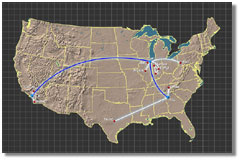 |
|
|
 |
||
|
||||||||||||||
|
NSF Announces Three Awards to Extend the Reach of Terascale Facility
|
|
|
|
ARLINGTON, Va.—The National Science Foundation (NSF) today announced $10 million in awards to Indiana and Purdue universities, Oak Ridge National Laboratory and The University of Texas to enhance the capabilities of NSF's Extensible Terascale Facility (ETF) with not only computing resources, but also scientific instruments and data collections. Through the new awards, the ETF will put neutron-scattering instruments and other unique resources online for the nationís research and education community.
The four awardees will join the five current partners in the ETF, a multi-year effort to build and deploy the world's largest, fastest, distributed computational infrastructure for general scientific research. The new awards fund the high-speed network connections needed to share resources across the ETF infrastructure, commonly known as the TeraGrid.
"These new awardees bring a rich mixture of shared computational resources, analytic tools and data assets that enable research and education at a scope and scale that was previously impossible," said Deborah Crawford, deputy assistant director of NSF's Computer and Information Science and Engineering directorate. "The resources and expertise these partners bring to the ETF demonstrate the great promise that a distributed cyberinfrastructure has to revolutionize science and engineering research and education in the 21st century."
Oak Ridge National Laboratory (ORNL) received $3.9 million to establish a 10-gigabit-per-second network connection that will integrate the neutron-scattering instruments at ORNL through a new ETF network hub to be located in Atlanta. Scientific disciplines ranging from biology and chemistry to earth sciences and semiconductor manufacturing use neutron scattering to probe the structure and dynamics of materials. As one of the laboratories of the U.S. Department of Energy (DOE), ORNL is connecting its High Flux Isotope Reactor and Spallation Neutron Source instruments, as well as ORNL's Center for Computational Sciences that houses leading edge high-end computing and storage resources, to the ETF, so that these rare and expensive resources may be widely used throughout the scientific community.
"The close partnership between NSF and DOE continues to generate tremendous value for the U.S. science and engineering research and education enterprise," Crawford said. ORNL is collaborating with partners at Duke University, Florida State University, the Georgia Institute of Technology, North Carolina State University, the University of Tennessee, the University of Virginia and Virginia Polytechnic Institute and State University.
Indiana University and Purdue University were together awarded $3 million to build a 20-gigabit-per-second connection from those institutions through Indianapolis to the existing ETF hub in Chicago. Indiana and Purdue will contribute up to 6.26 teraflops (trillions of calculations per second) of computing capability; up to 400 terabytes of data storage capacity; visualization resources; specialized instrumentation including the Purdue Terrestrial Observatory and a number of life science data sets deriving from Indiana University's Indiana Genomics Initiative.
At The University of Texas, the Texas Advanced Computing Center (TACC) was awarded $3.2 million to establish a 10-gigabit-per-second network connection from Austin, Texas, to the new ETF hub in Atlanta. TACC is contributing access to high-end computers capable of 6.2 teraflops, its new terascale visualization system, the center's 2.8-petabyte mass storage system and geoscience data collections. These collections include high-resolution digital terrain data, worldwide hydrological data, global gravity data and high-resolution X-ray computed tomography data, which are invaluable research tools for scientists in environmental, geological, climate and biological research programs.
NSF launched the ETF in August 2001 with $45 million in funding to four sites: the National Center for Supercomputing Applications at the University of Illinois, Urbana-Champaign; the San Diego Supercomputer Center at the University of California, San Diego; Argonne National Laboratory in Argonne, IL; and the Center for Advanced Computing Research at the California Institute of Technology in Pasadena. In October 2002, the Pittsburgh Supercomputing Center joined the ETF partnership when NSF announced $35 million in supplementary funding.
The initial ETF partners and awards are providing 20 teraflops of computing power distributed at five sites, facilities for managing and storing nearly 1 petabyte of disk-accessible data, high-resolution visualization environments and toolkits for grid computing. These components will be tightly integrated and connected through a network backbone that will operate at 40 gigabits per second—the fastest research network on the planet.
Also see:
Fact Sheet: From Supercomputing to the Teragrid
Site contacts:
Indiana University: Michael McRobbie, 812-855-5752, mcrobbie@indiana.edu
Oak Ridge National Laboratory: Thom Dunning, 865-576-0750, dunningthjr@ornl.gov
Purdue University: Jim Bottum, 765-496-2266, jb@purdue.edu
University of Texas: Jay Boisseau, 512-471-8197, boisseau@tacc.utexas.edu
NSF Terascale Extensions program: http://www.cise.nsf.gov/fndg/pubs/display2.cfm?pub_id=6467÷=acir
TeraGrid: http://www.teragrid.org/
The National Science Foundation (NSF) is an independent federal agency that supports fundamental research and education across all fields of science and engineering, with an annual budget of nearly $5.3 billion. NSF funds reach all 50 states through grants to nearly 2,000 universities and institutions. Each year, NSF receives about 30,000 competitive requests for funding, and makes about 10,000 new funding awards. The NSF also awards over $200 million in professional and service contracts yearly.
Receive official NSF news electronically through the e-mail delivery system, NSFnews. To subscribe, send an e-mail message to join-nsfnews@lists.nsf.gov. In the body of the message, type "subscribe nsfnews" and then type your name. (Ex.: "subscribe nsfnews John Smith")
Useful NSF Web Sites:
NSF Home Page: http://www.nsf.gov
News Highlights: http://www.nsf.gov/od/lpa
Newsroom: http://www.nsf.gov/od/lpa/news/media/start.htm
Science Statistics: http://www.nsf.gov/sbe/srs/stats.htm
Awards Searches: http://www.fastlane.nsf.gov/a6/A6Start.htm
|
|
